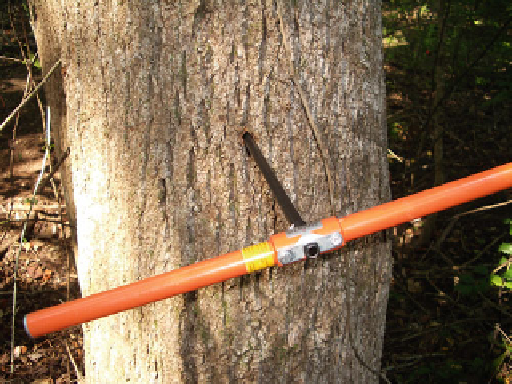Environmental Engineering Reference
In-Depth Information
(DGGE), can be used. Brigmon et al. (1999) used a direct
fluorescent antibody (DFA) technique to determine the pres-
ence of methanotrophic bacteria that produce MMO in order
to understand the potential for TCE to be gratuitously
degraded at a site, as was discussed in Chap. 13.
To resolve to a higher degree if the bacteria needed to
degrade specific contaminants are present then molecular
techniques are required. Molecular markers can be used to
distinguish one species of bacteria from another. A type of
marker widely used is called an antibody resistance marker,
such as rifampicin and streptomycin. A very specific marker,
such as beta-glucuronidase (
gus
A) gene, is called an
introduced marker gene (Wilson 1995). This method can
make visible, through a colored product, the plant-root colo-
nization of strains that contain that gene. Another approach
is the enzyme-linked immunosorbent assay (ELISA)
method, where antigens on the cell surface are recognized
by specific antisera. Molecular methods are useful because
they are based on the genetic characteristics unique to spe-
cific microbes, such as those that inhabit the rhizosphere.
The DNA contained in cell nuclei is the key to under-
standing the inner and outer workings of both bacteria and
plants. The DNA contains the genetic information to code
for the production of various proteins that are used for
different purposes. The first step in unlocking any question
that may be related to DNA, therefore, is to isolate it from all
the other materials that are contained in the cell or that the
cell has come into contact with during preparation for DNA
isolation.
DNA is not organized like other cell parts, that is, of
carbon or hydrogen atoms, but rather of linear segments
of DNA called genes. These are composed of a series of
interconnections between four amino acid (protein) bases.
This linear genetic code can be copied onto mRNA, which is
then used to make linear proteins. Phospholipid fatty acids
are present in all cells and can be extracted from cell
mixtures easily. It is this characteristic that makes the use
of PLFA a preferred method over use of MPN to determine
microbial biomass in the subsurface. Gene probes can be
used to measure the prevalence of specific genes at a site.
The efficiency of their use as a provider of accurate numbers
still remains in question, however.
Fig. 15.1
An increment borer used to collect tree cores. The borer
has been advanced but the inner sleeve not yet inserted (Photograph
by author).
once in the transpiration stream the fate of the contaminant
can be assessed using similar approaches.
A simple approach that has received much attention is the
collection of various tree tissues, such as bark, stems, leaves,
as well as material cored from the trunk using an increment
borer (Fig.
15.1
). The collection of core material for analysis
of tree health has been a standard technique of the forestry
industry for many years (Grissino-Mayer 2003), and gained
initial use for hydrologists as an indicator of hydrologic
change (Phipps 1967; Helley and LaMarche 1973; Phipps
et al. 1978; Zimmerman 1989). The method used may differ
slightly among users but consists of inserting an increment
borer into a tree, turning it to advance the borer, then
inserting a steel sleeve, and then retrieving the core, as
documented in user guides by Phipps (1985) and Grissino-
Mayer (2003).
The relation between the presence of trace elements in the
tree and their source from surface water was investigated
using tree cores as early as the 1970s by Sheppard and Funk
(1975), from soil (McClenahan et al. 1989), and from
groundwater (Kalisz et al. 1988). The collection and analysis
of other tree tissues also has a long history. Moreover, even
some of these early investigators understood that the ulti-
mate source of the minerals being investigated in the plant
tissues was either from the soil or from the soil-water profile,
including groundwater. Some plants can accumulate in them
elements at higher concentrations than exist externally, such
as selenium accumulation by
Astragalus spp.
(Anderson
et al. 1961), or can contain lower concentrations than those
measured outside the plant, such as is the case with sodium
or chloride.
Due to the potential deleterious effect of such salts on the
survival of plants due to disruption of the osmotic process of
15.1.2 Plant Tissue Samples
As was discussed in Chap. 12, the direct uptake of ground-
water contaminants by phreatophytes such as poplar trees
commonly installed at sites characterized by contaminated
groundwater can occur by the aqueous pathway (McFarlane
et al. 1990) or by the gaseous pathway (Bromilow and
Chamberlain 1995; Neitch et al. 1999). Regardless of the
physical state of the contaminant being taken up, however,


Search WWH ::

Custom Search